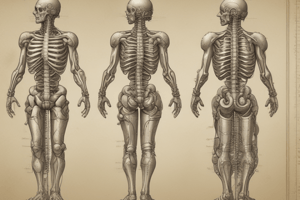Podcast
Questions and Answers
What is the main function of the vertebral column?
What is the main function of the vertebral column?
- To separate the thoracic and lumbar regions
- To support the bony trunk of the body and facilitate movement
- To provide a flexible supporting column for the upper body only
- To protect the spinal cord and transmit weight to the lower limbs (correct)
What is the average number of separate bones in the vertebral column of a young child?
What is the average number of separate bones in the vertebral column of a young child?
- 20
- 26
- 33 (correct)
- 29
What is the main component of the spinal canal?
What is the main component of the spinal canal?
- Vertebral bones
- Vertebrae discs
- Spinal cord (correct)
- Cerebrospinal fluid
What is the term used to describe the curves of the vertebral column when viewed from an anterior perspective?
What is the term used to describe the curves of the vertebral column when viewed from an anterior perspective?
Where does the spinal cord terminate?
Where does the spinal cord terminate?
What is the main reason why the cartilaginous disks between the inferior lumbar vertebrae are common sites of injury and pathology?
What is the main reason why the cartilaginous disks between the inferior lumbar vertebrae are common sites of injury and pathology?
What is the primary function of the intervertebral disks?
What is the primary function of the intervertebral disks?
What is the correct term to describe the region of the next 12 vertebrae after the cervical vertebrae?
What is the correct term to describe the region of the next 12 vertebrae after the cervical vertebrae?
How many sections is the vertebral column divided into?
How many sections is the vertebral column divided into?
What is the number of cervical vertebrae found in an average person?
What is the number of cervical vertebrae found in an average person?
Flashcards are hidden until you start studying
Study Notes
Vertebral Column
- The vertebral column, also known as the spine or spinal column, is a complex of many bones called vertebrae.
- It provides a flexible supporting column for the trunk and head and transmits the weight of the trunk and upper body to the lower limbs.
- The vertebral column is located in the midsagittal plane, forming the posterior or dorsal aspect of the bony trunk of the body.
Spinal Canal
- The spinal canal is a tubelike, vertical structure that follows the curves of the spinal column, beginning at the base of the skull and extending into the sacrum.
- It contains the spinal cord and is filled with cerebrospinal fluid.
Spinal Cord
- The spinal cord is enclosed and protected by the spinal canal, beginning below the medulla oblongata of the brain.
- It continues through the first cervical vertebra to the lower border of the first lumbar vertebra, where it tapers off to a point called the conus medullaris.
- In some individuals, the conus medullaris may extend to as low as the body of L2.
Intervertebral Disks
- Tough fibrocartilaginous disks separate typical adult vertebrae, providing cushioning and allowing for flexibility and movement of the vertebral column.
Sections of Vertebral Column
- The vertebral column is divided into five sections: cervical, thoracic, lumbar, sacrum, and coccyx.
- Each section has distinctive characteristics, with the cervical and thoracic vertebrae covered in this chapter, and the lumbar vertebrae, sacrum, and coccyx covered in Chapter 9.
Cervical Vertebrae
- The first seven vertebrae are cervical vertebrae, with an average of seven vertebrae in an adult.
- There may be slight variation in the height of each vertebra among individuals.
Thoracic Vertebrae
- The next 12 vertebrae are thoracic vertebrae, each connecting to a pair of ribs.
- The term "thoracic" is more correct for describing this region than the older term "dorsal spine".
Lumbar Vertebrae
- The five lumbar vertebrae are the largest individual vertebrae, and the strongest in the vertebral column due to the increasing load of body weight.
- The cartilaginous disks between the inferior lumbar vertebrae are common sites of injury and pathology.
Sacrum and Coccyx
- The sacrum and coccyx develop as multiple separate bones that fuse into two distinct bones.
- A newborn has five sacral segments and three to five (average, four) coccygeal segments, for an average of 33 separate bones in the vertebral column.
- In the adult, the vertebral column is composed of an average of 26 separate bones.
Studying That Suits You
Use AI to generate personalized quizzes and flashcards to suit your learning preferences.




